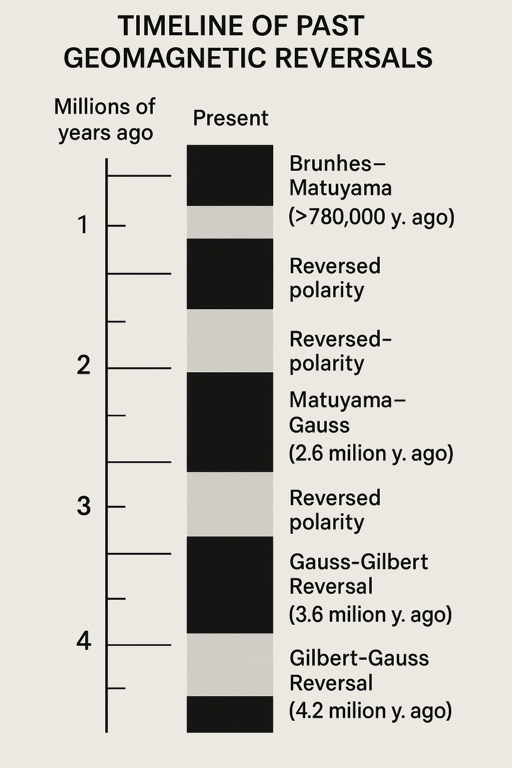🔄 Why the Magnetic Field Weakens
- Natural Fluctuations: The magnetic field isn't static. It constantly shifts, strengthens, and weakens due to fluid motion in Earth’s outer core (where molten iron generates the magnetic field via the geodynamo effect).
- Geomagnetic Reversals: Occasionally, the magnetic poles flip — the North becomes South and vice versa. This has happened hundreds of times over Earth's history, most recently ~780,000 years ago (Brunhes–Matuyama reversal).
⚠️ Key Implications of a Weakened Magnetic Field
1. Increased Radiation Exposure
- The magnetic field acts like a shield against cosmic rays and solar wind.
- A weaker field means more charged particles from the sun and space reach the upper atmosphere and potentially the ground.
- Impacts:
- Increased radiation on flights and in space missions.
- Auroras may be seen at lower latitudes.
- Potential health risks for astronauts and airline crews on polar routes.
2. Damage to Satellites and Technology
- More energetic particles can disrupt electronics in satellites (e.g., GPS, communication).
- Solar storms could cause power grid blackouts, similar to the 1989 Quebec blackout.
3. Navigation Problems
- A shifting or weakening field could affect animal migration, which relies on geomagnetic cues (e.g., birds, turtles, whales).
- Compass-based systems (though largely obsolete now) would become less reliable.
- Modern aviation and military navigation might require recalibration.
4. Atmospheric Changes
- Weaker magnetic shielding could allow more solar particles to strip the atmosphere, especially the ozone layer.
- This is not as extreme as Mars (which lost its magnetic field long ago), but long-term exposure could have effects on climate and atmospheric chemistry.
5. No Catastrophe – But Risks Exist
- There is no evidence that past field reversals caused mass extinctions.
- However, a rapid weakening or prolonged dip (called a geomagnetic excursion) could stress modern electrical infrastructure and satellite systems.
🧭 South Atlantic Anomaly (SAA) – A Current Example
- This is a region over South America and the South Atlantic where the magnetic field is unusually weak.
- It’s growing and drifting westward.
- Satellites passing through it experience higher error rates and radiation damage.
📉 How Weak is It Getting?
- Earth's magnetic field has weakened by about 10% over the last 150 years.
- Some scientists think we might be entering a reversal phase, but it could also be just a temporary fluctuation.
🧠 Summary
| Aspect | Implication |
|---|---|
| Space weather | More exposure to solar storms |
| Human tech | Satellite disruption, grid risks |
| Biology | Animal migration affected |
| Health | Radiation exposure in high altitudes |
| Climate | Slight potential atmospheric impacts |
| Catastrophe risk |
Low – but vigilance needed |



